How AI Reduces Programmatic Advertising Fraud

Programmatic advertising fraud has become a digital monster preying on the goals and dreams of B2B marketers everywhere.
Imagine a time not so long ago when digital media and content platforms were in full swing. Demand for digital advertising space was skyrocketing. The classic “insertion order” was no longer productive. B2B marketers were under pressure to work faster, harder, and efficiently than ever to meet their business requirements.
It was perfect timing for technology developed for fully automated trading of advertising – Programmatic Marketing. With it, B2B marketers reduced their dependence on human-to-human interaction while still meeting their advertising requirements. But, at the same time, programmatic marketing has had its problems that you (as B2B marketers) can’t ignore.
What Is Programmatic Ad Fraud?
Before jumping into why ad fraud has become a such threat and problem for programmatic marketing, let’s first understand what ad fraud means and how scammers perform this activity.
In simplest terms, ad fraud is the practice of generating revenue fraudulently either by fake clicks, phony installs, simulated in-app actions, or falsely inflated impressions. Scammers carry out programmatic ad fraud activity in various ways:
- Use bots to drive large volumes of traffic to websites
- Buy cheap traffic through auto redirects
- Employ people to install apps in click farms
- Ads piled on top of each other to generate impressions for multiple ads
Whatever method they practice to carry out ad fraud, their sole purpose is to trick you out of money. Not good.
Risk of Ad Fraud Increasing
With the rise of marketing automation, DSPs and SSPs, and other digital processes, the potential for ad fraud increases, causing huge losses for some B2B businesses. Juniper Research says that the global loss to Ad Fraud in 2019 was $42 billion and is expected to grow to $100 billion in 2023.
The report also claims that instead of using labor-intensive activities such as app-install farms, fraudsters will shift to advanced techniques such as spoofing advertising networks to falsify ad clicks and displayed ads.
With such a scary scenario today, ad fraud has become the second biggest market for organized crime (behind cocaine and opiate trafficking). However, it’s been predicted that by the end of 2025, it will be the largest market for organized crime, worth some $50 billion.
How to Avoid Programmatic Ad Fraud
An effective way to avoid programmatic fraud is none other than artificial intelligence combined with machine learning.
Artificial Intelligence (AI) refers to the simulation of human intelligence in machines programmed to think like humans and mimic their actions. AI-based programmatic helps you analyze human behavior patterns within website and mobile app user flows, and it can differentiate between bots and humans. Also, it helps to avoid pushing irrelevant messaging. Instead it allows B2B marketers to use buyer data to create personalized campaigns that are significant and engaging.
On the other hand, machine learning (ML) is an application of artificial intelligence that enables the system to automatically learn and improve from experience without being explicitly programmed. ML is based on algorithms to study and analyze the connections between patterns and behaviors with time. Based on that analysis, it allows B2B sellers to make better decisions and detect programmatic ad frauds.
Take an AI-based Approach to Programmatic Advertising
Ad fraud costs billions of dollars and wastes hard-earned digital marketing campaigns and budgets. If you want to be vigilant and proactive, it's worth implementing an AI-based fraud detection approach. Contact our data professionals if you have any questions.
If you’re keen to avoid other problems of programmatic marketing, continue learning with this article: Smash These Five Challenges in B2B Programmatic Advertising.

